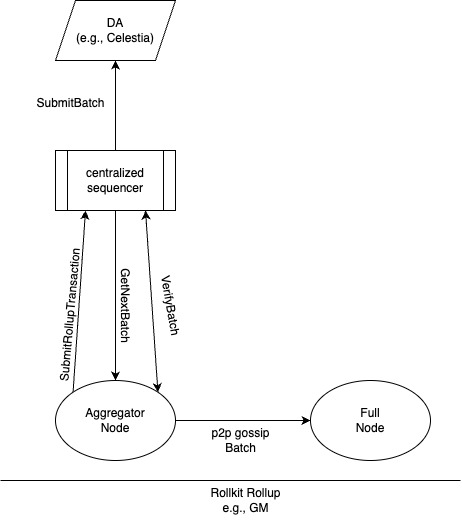Centralized Sequencer
A centralized sequencer is a sequencing middleware that receives rollup transactions and provides a local sequencing capabilities. Meaning, the transactions are ordered in the order they are received by the sequencer without any censorship. Further, the sequenced batches are made available in the DA network (such as Celestia). Under the hood, the centralized sequencer is a GRPC server that implements go-sequencing interface and the server is hosted by the same node that is running the aggregator for the Rollkit rollup.

Prerequisites
This tutorial serves as a comprehensive guide for using the centralized-sequencer with your chain.
Before proceeding, ensure that you have completed the quick start or build a chain tutorial, which covers installing the rollkit CLI, building your chain, and running your chain.
TIP
It is important to note that the centralized sequencer expects a DA layer to be running when it starts. This means that you need to launch your DA Layer before starting the centralized sequencer.
Additionally, you should have completed one of the DA Layer tutorials and have your DA layer ready to use with the centralized sequencer. This tutorial will use the local-da layer as an example.
Installation the Centralized Sequencer
git clone --depth 1 --branch v0.4.0 https://github.com/rollkit/centralized-sequencer.git
cd centralized-sequencer
make build
./build/centralized-sequencer -hUsage:
-host string
centralized sequencer host (default "localhost")
-port string
centralized sequencer port (default "50051")
-listen-all
listen on all network interfaces (0.0.0.0) instead of just localhost
-rollup-id string
rollup id (default "rollupId")
-batch-time duration
time in seconds to wait before generating a new batch (default 2s)
-da_address string
DA address (default "http://localhost:26658")
-da_auth_token string
auth token for the DA
-da_namespace string
DA namespace where the sequencer submits transactions
-db_path string
path to the databaseAs shown by the help command, a centralized sequencer is configured to serve a rollup (via rollup_id). The DA network to persist the sequenced batches are specified using da_address, da_auth_token and da_namespace.
Run the centralized sequencer
TIP
As mentioned in the prerequisities, you should have your DA layer running. These steps assume the local-da is running on http://localhost:7980.
Start your centralized sequencer with the following command:
./build/centralized-sequencer -rollup-id my-rollup -da_address http://localhost:7980./build/centralized-sequencer -rollup-id wordle -da_address http://localhost:7980Run your chain
To connect your chain to the centralized sequencer, you need to pass the --rollkit.sequencer_address flag with the local sequencer address and the --rollkit.sequencer_rollup_id to ensure your rollup id matches what the sequencer is expecting.
Start your chain with the following command, ensuring to include the sequencer flag:
rollkit start \
--rollkit.da_address http://localhost:7980 \
--rollkit.sequencer_address localhost:50051 \
--rollkit.sequencer_rollup_id my-rolluprollkit start \
--rollkit.aggregator \
--rollkit.da_address http://localhost:7980 \
--rollkit.sequencer_address localhost:50051 \
--rollkit.sequencer_rollup_id wordleYou should see the following log messages indicating that your chain is connected to the local sequencer:
I[2024-11-15|15:22:33.636] sequencer already running module=main address=localhost:50051
I[2024-11-15|15:22:33.636] make sure your rollupID matches your sequencer module=main rollupID=my-rollupThen after a few blocks you should see this message confirming that your sequencer is successfully submitting batches to the DA layer:
I[2024-11-15|16:04:07.698] successfully submitted Rollkit headers to DA layer module=BlockManager gasPrice=-1 daHeight=1 headerCount=14Summary
By following these steps, you will have successfully set up and connected your chain to the centralized sequencer. You can now start submitting transactions to your chain.

